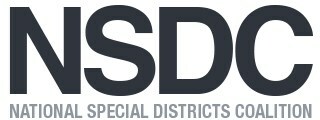Advancing Top Priority, NSDC Formally Proposes Federal Definition of 'Special District'
WASHINGTON, D.C., May 16, 2023 /PRNewswire/ -- The National Special Districts Coalition (NSDC) announced Wednesday its proposed federal definition of "special district," marking a pivotal step in the organization's top federal policy priority.
Despite approximately 35,000 special districts providing essential local government services to millions of Americans, there is no single definition for "special district." The absence has led to inconsistencies in how special districts are referenced as eligible for federal programs and additional hardship to access federally-sourced assistance for infrastructure projects and community programs.
The NSDC Executive Committee unanimously approved the definition, which a working group of the nation's special district leaders crafted and submitted. NSDC's proposed federal definition of "special district" reads:
"Special District" ? A political subdivision of a State, with specified boundaries, created pursuant to general law or act of the State, for the purpose of performing limited and specific governmental or proprietary functions, except that is not a school district, college, county, city, town, township, village, parish, borough, or other general purpose unit of government.
The NSDC-proposed definition will be the cornerstone of future Coalition advocacy on the subject. Federal special district advocates aim to secure the definition to set a benchmark for the term. Meanwhile, advocacy will continue to ensure special districts are eligible for relevant federal programs soon to be considered for reauthorization or in pertinent legislation proposing new programs to assist local government services.
While an early definition was legislatively posed in the 116th and 117th Congresses with the Special Districts Provide Essential Services Act, the nation's special district leaders and stakeholders recognized a need in early 2023 to revisit the previous definition with greater engagement as the Coalition has developed, with more dedicated time, and with additional discussion and deeper analysis.
"This definition is the culmination of three years of nationwide outreach, coalition building, research, and of promoting awareness of special district services to members of Congress and the Executive Branch ? with more work to do ahead," said Neil McCormick, NSDC Chairman and California Special Districts Association Chief Executive Officer. "A special thank you to members of NSDC's working group and all supporting partners for their dedication to this effort. The Coalition looks forward to working with grassroots, state, and national special districts stakeholders as well as fellow local government organizations to ensure special districts are defined, understood, and may experience greater access to federally-funded programs for local government."
"This proposal has been a long time in the making, and the National Special Districts Coalition is excited to advance and place the definition of 'special district' in federal law," said Ann Terry, NSDC Vice-Chair and Special Districts Association of Colorado Executive Director. "With this well-vetted, solid definition, the Coalition will move to ensure special districts are able to access federal resources to robustly provide essential services in their communities."
The NSDC Working Group to Define "Special District" was comprised of special district leaders and stakeholders from Arizona, California, Colorado, Florida, Oregon, South Carolina, Utah, Washington, and Wyoming. The working group rigorously examined how special districts fit within the structures of local government across state lines, received input from the NSDC Advocacy Team (TFG and Paragon Government Relations), and met with U.S. Census Bureau representatives for deeper discussions on how the federal government classifies special districts in its local government statistics.
Special districts are local governments created by a community to perform a specific service, or services, that another unit of government is not otherwise providing. Special districts have their own tax and revenue base, may issue bonds, and are overseen by locally-elected or locally-appointed boards of directors. Common services special districts provide include drinking water, wastewater treatment, fire protection, emergency response, port and harbor, hospital, irrigation, electricity, park and recreation, library, resource conservation, airport, cemetery, mosquito abatement, transit, flood control, and more.
The National Special Districts Coalition is the only national organization federally representing and advocating for all special districts. The Coalition strives to advocate for elevate awareness of the nation's special districts and the critical, essential services they provide in thousands of communities to millions of Americans.
For more information on efforts to federally define "special district" and questions on how to get involved with the Coalition, contact Cole Arreola-Karr, NSDC Federal Advocacy Director, at [email protected].
Members of the National Special Districts Coalition include:
California Special Districts Association
Special Districts Association of Colorado
Florida Association of Special Districts
Special Districts Association of Oregon
South Carolina Association of Special Purpose Districts
Utah Association of Special Districts
Wyoming Association of Special Districts
Arizona Fire Districts Association
Association of Washington Public Hospital Districts
Washington Association of Sewer and Water Districts
Washington Fire Commissioners Association
Washington Public Utility Districts Association
The National Special Districts Association appreciates affiliate support from Public Trust Advisors, Streamline, EveryLibrary Institute, and Roach & Associates, PLLC.
Media Contact
Cole Arreola-Karr
[email protected]
SOURCE NSDC
News published on and distributed by:




